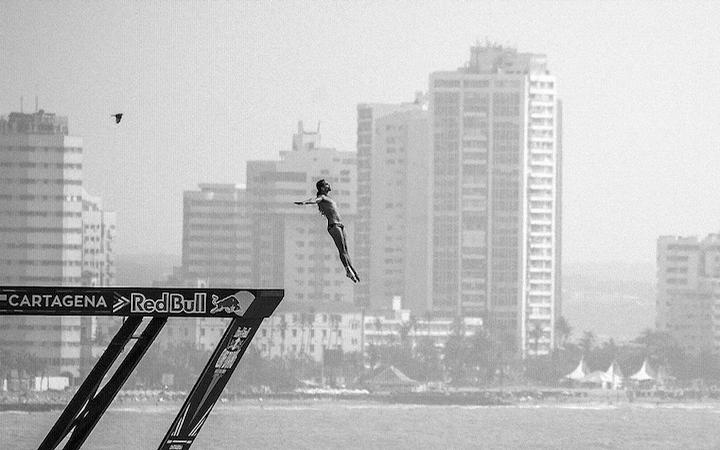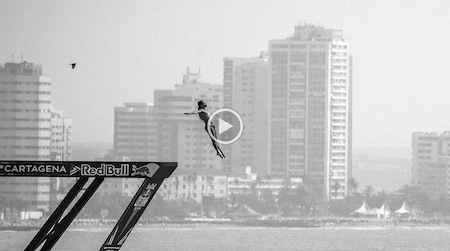
The Art of Falling
5 May 2015, 2:28PM
quattro media
The Red Bull Cliff Diving World Series is high, fast and demands absolute physical control. Do you want an idea of what cliff diving is? You’ve heard about the height, the speed and the impact but can’t imagine the real dimensions of this rapidly-progressing sport? Picture the following: stand on a balcony on the eighth storey and look down – 27m, that’s the height.
Accelerate your car from 0-85kph in three seconds – unless you’re steering a sports car, you won’t be quick enough. The force on impact is enormous and stops you within one second. You have to be stronger than the water; otherwise, rather than you breaking the water, it’ll break you. Cliff diving is a beautiful sport, which is both pure and intense.
For the athletes, cliff diving is the higher version of regular Olympic diving where the maximum height is 10m. The technique, the dives, the preparation and basic skills are all the same. The two main differences are the feet-first entries and the height. Cliff divers almost triple it and dive off a 27m high platform. This allows you to fit a lot more flips and a lot more twists into a single dive, but the principles remain the same. It is the height that means divers really have to show control in order to dive successfully, and with the progression of diving, they need this much room to execute all the manoeuvres in the air in the harder dives. “I was happy diving from the 1m springboard as a kid and I’m just happy that I can continue diving now. At the end of the day it’s pretty extreme what we’re doing, but at the same time it’s still diving and just keeping that passion for what you love,” explains Steven LoBue, who finished third overall in the 2014 Red Bull Cliff Diving World Series.
In cliff diving the judging criteria are the same as in Olympic diving: the judges look at the take-off, they look at the execution in the air and the entry. “As we jump from the platform the judges look for a nice take-off. They want to see a strong push, a strong jump when you do a dive. Once you’re in the air you have to do these exact manoeuvres that you roll down. They’re looking for exactly those things, you cannot improvise, you cannot freestyle, you cannot change it in the air,” describes Colombia’s Orlando Duque, the owner of 12 world titles in this sport, “they are looking exactly for that one dive! And also they look for clean lines, nice arms, nice legs, good position in the air and finally water entry – no splash!
They want to see clean entries, a nice sound and the combination of that gives you 10 points!”
And those 10 points don’t come by relaxing in the air. It all starts with a great take-off, because once you’re in the air, it’s very difficult to change something. All the rotational speed for the somersaults and twists comes from the jump off the platform. What happens in the air exactly is hard to explain. “It’s sort of a blur. I try to think about it all the time, but your body just goes on “autopilot”. I’ve been diving for 21/22 years now and I’ve been into high diving since 2011; so all those movements are just engrained and the second you leave the platform, your body just kind of takes over and knows what to do,” says American Steve LoBue, “Definitely on the easier dives, when you take off, you’re going to really feel that
wind in the hair and you are really going to feel the acceleration, you can hear the acceleration and that’s what’s a little bit scary.” From 0-85kph in less than three seconds – that’s speed in its purest form.
A regular family car would not be able to catch up with the free-fall of a cliff diver!
Within the blink of an eye, the feet of the divers touch the water and it’s the moment when the enormous force of entry impacts on the body. You need to rip the entry and you still need to stay strong under the water, as a good entry doesn’t always save you from injuries during the deceleration process. According to the divers, water acts in mysterious ways and the body can be moved into unexpected positions, so it’s something you must always respect.
Besides the actual performance of a dive, what also comes into play is the mental aspect, which is one of the biggest challenges of cliff diving. “It’s one of the only sports where you can’t really train every day from 27 metres and so you really have to train your brain to imagine exactly how it would feel to train from those heights,” explains four-time World Series champion Gary Hunt. Mind and body have to be really connected, that is the only way of ensuring that everything is going to work the way it should.
Having mastered gravity for three seconds, you resurface from the water surrounded by air bubbles and experience a feeling that’s indescribable. “It’s such a rush, it is a lot of fun, you feel the blood pumping, you feel like you’re alive again!” – that’s how Orlando Duque, a third-place finisher in the season-opener in Cartagena, Colombia, describes it. Russia’s Artem Silchenko, the 2013 World Series champion, has an almost poetic approach to it: “In our lives we have a lot of rules and on the platform I have my own rules. I can do what I’ve prepared myself to do, how I want to do it and nobody can tell me anything. It’s freedom; it’s beautiful!”
Video - Red Bull Cliff Diving World Series 2015 – The basics of Cliff Diving – Cartagena, Colombia

Photo credit: © Red Bull Media House


